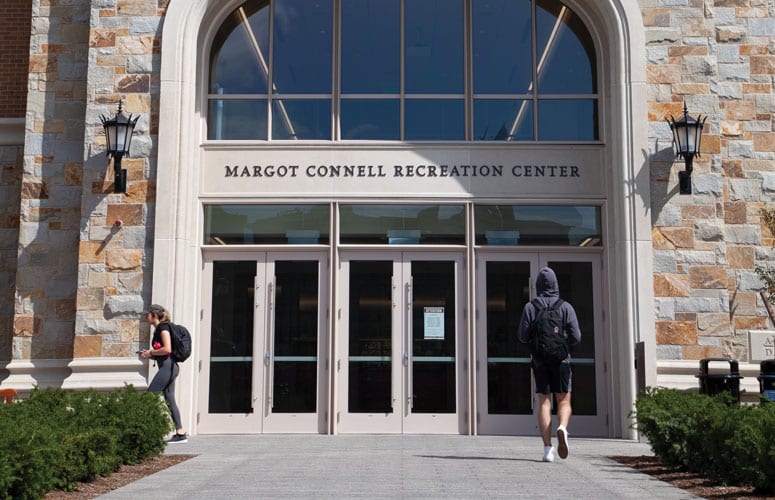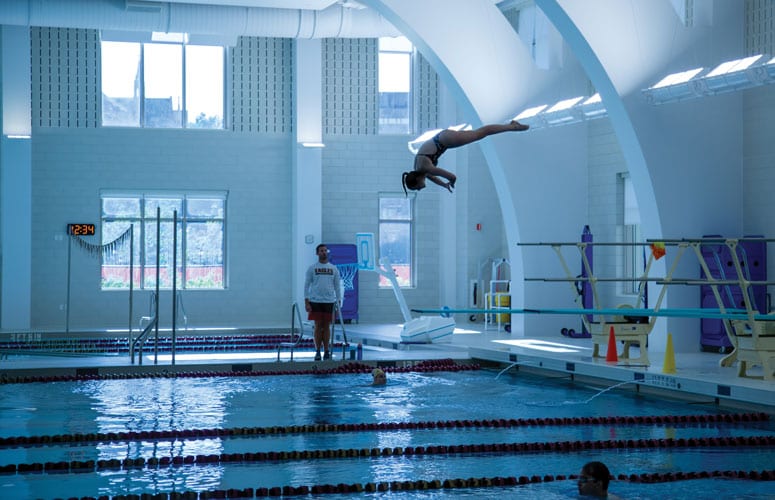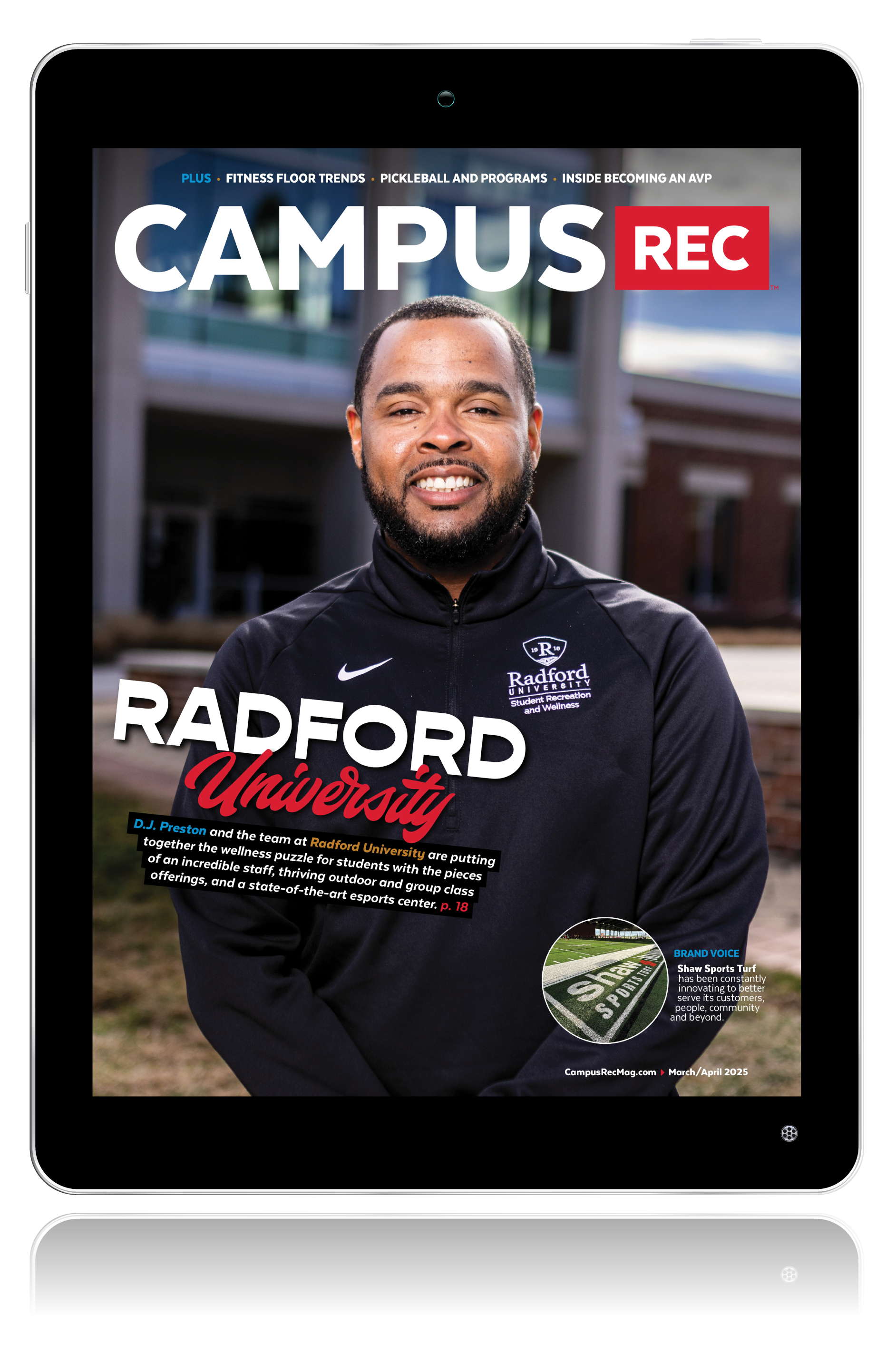In 1630, a ship carrying Puritans from England sailed into Massachusetts Bay, and Boston was born.
Rich with history, Boston grew and thrived. A little over 200 years after the city was founded, Boston College was established.
Since 1863, it’s been growing while staying rooted in its history. But even the historic needs a restoration every once in awhile, livening up history and making it glow once more. And that’s what the Margot Connell Recreation Center did for Boston College’s campus recreation.
At 244,000 square feet, the rec center opened mid-2019 as a state-of-the-art facility for the campus. With an expansive track, basketball and indoor tennis courts, fitness neighborhoods, windows, air conditioning, and more, it brings a new vibrancy to the Boston College campus.
Rebecca Cegledy, the associate athletic director and campus recreation director, said her favorite part about the new center are the windows. “The natural light and views out to campus and the reservoir are amazing,” she said. “It fills me with energy, but also grounds me, and I hope our members are able to have that same experience.”
She noted their old facility, like many campus recreation centers of the past, had eight windows, seven of which were on the front entrance and one behind the curtain on an emergency exit door. “We had thousands of people in the building, but from the outside, that energy was lost,” noted Cegledy. “The [new] facility also brings a new vibrancy to this part of lower campus, and part of that is from the windows and being able to see all the activity going on inside.”
Cegledy was part of the campus recreation leadership team that managed the project, alongside Boston College Capital Projects, the CannonDesign architects and the Skanska construction company.

Colleen McKenna at CannonDesign was the project principal and said while working with the Boston College team throughout the process, she noted they were continually focused on their mission: helping students be healthier for generations. “The Connell Recreation Center is designed to ensure Boston College achieves that mission,” she said. “What thrills me about the new recreation center is that it truly reflects the heart and soul of the campus community.”
One of the ways the new rec center does this is through its nod to Boston College’s history. Whether it’s the outside facade of the building, which has retained that collegiate gothic look, or adding a hill to the indoor track — paying homage to Heartbreak Hill on Mile 21 of the Boston Marathon — the facility hasn’t forgotten the rich history surrounding it.
But, that nod didn’t just happen. Cegledy said one of the major lessons she learned during the project was to make sure to have a great fit with your construction company and architects. Both continually checked in with the campus recreation team to make sure their vision was implemented.
On top of this, Cegledy also noted a few other tips she picked up during the project: follow up on every conversation/meeting with an email to have a written record; use active listening strategies to make sure everyone is on the same page; and finally, finish up meetings by assigning action items and making sure everyone knows who is responsible for what.
And, don’t be afraid to ask. For example, Cegledy made a comment on a walk through of the center that they could consolidate the individual storage spaces for a few of the varsity teams in the tennis area. No one said no, and now the spaces are revamped to have more open-face lockers, soft seating and TVs. “It is true: the worst they can say is no, but imagine if they say yes,” said Cegledy.
Beyond the design of the new center, what it holds on the inside is highlighted by its numerous windows and a stellar staff.
Eli Crispell, the assistant director of the outdoor adventure program, helped with the design process of the outdoor adventure space. He said the commitment to the end users and how they would use the space delivered a fantastic product. The lounge is his favorite aspect of the space for one simple reason: student leaders.
Crispell noted about 40 students volunteer over 2,000 hours collectively and spend hundreds of hours in training. “Being able to give them a space to relax, bond and continue to grow as a community is an amazing thing to be able to offer them,” he said.
In fact, that coincides with Crispell’s one piece of advice he’d give other rec professionals: believe in your students. He said if you set high standards of excellence and hold them to it, you just might be surprised at the results.
One program that excels because of such student leaders is Wild Eagles, an outdoor adventure program for new Boston College students. Over six days, students are broken up into groups of six new students and two experienced leaders. They head into the wilderness to take on whatever the adventure may be — rock climbing, canoeing, backpacking, etc.
“The day they return to campus is one of the most inspirational of the year,” said Crispell. “They left as eight individuals, a little scared, a bit overwhelmed and with that, ‘I’m new and out of place’ feeling. When they return, they have community … That belonging is really why we do it.”
Hilary De Vries, the assistant director of fitness and wellness, echoed Crispell in their reliance on student staff, as well as the exceptional work the outdoor adventure program is doing.

But, not every student hits the outdoors; some just want to get on exercise equipment and go. De Vries had a large hand in the fitness equipment selection and layout process during the project. She tested equipment, contacted vendors, built competitive bids and purchased what was needed. Then it had to be placed. “The equipment layout process was such a challenge since our fitness equipment had to be on three different floors, but I found this to be an incredible learning experience and one I greatly enjoyed,” said De Vries. “I loved the challenge of creating floor plans and working with vendors, especially Molly Forbes and Life Fitness.”
However, she had to think beyond the typical equipment of the past. De Vries said they have incorporated an adaptive fitness section, as well as functional training and Olympic lifting and powerlifting areas, to meet the diverse needs of their students. They even thought of staff development and added in equipment, like TRX and Queenax, that required additional training so students could continue to grow. “In life in general, gathering perspectives is incredibly important and it was no different here when working to offer diverse and intentional opportunities,” she said.
Diverse opportunities at Boston College’s campus recreation don’t stop with equipment, but also include programs. For example, the faculty and staff wellness program has been so well received on campus that a faculty/staff fitness and wellness coordinator position was added October 2018. De Vries said the program is in partnership with human resources in order to offer a partial covering of cost for eligible faculty and staff on small group training classes, road races, etc.
In the end, the entire project and the decisions made came down to a commitment to developing the whole person in student, faculty and staff. It’s being accomplished through the new rec center, but also through diverse and inclusive athletic and recreation opportunities, as well as meeting social needs.
All in all, the focus during the project was creating a dynamic space to workout, to fulfill goals and to simply bring a new vibrancy to the historic campus.
“Boston College committed to an inspiring vision for the project,” said McKenna. “It was an honor to work with the college and make their vision a reality. It’s a model for others across the country to follow.”










